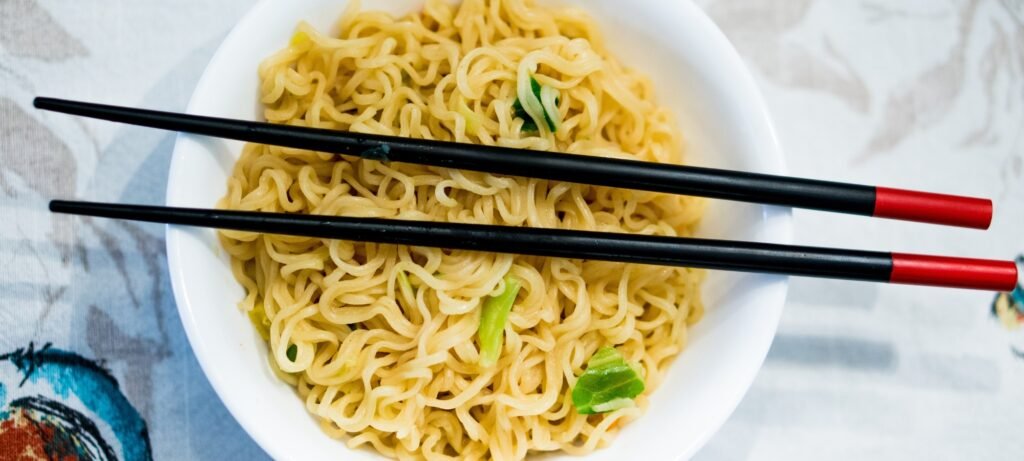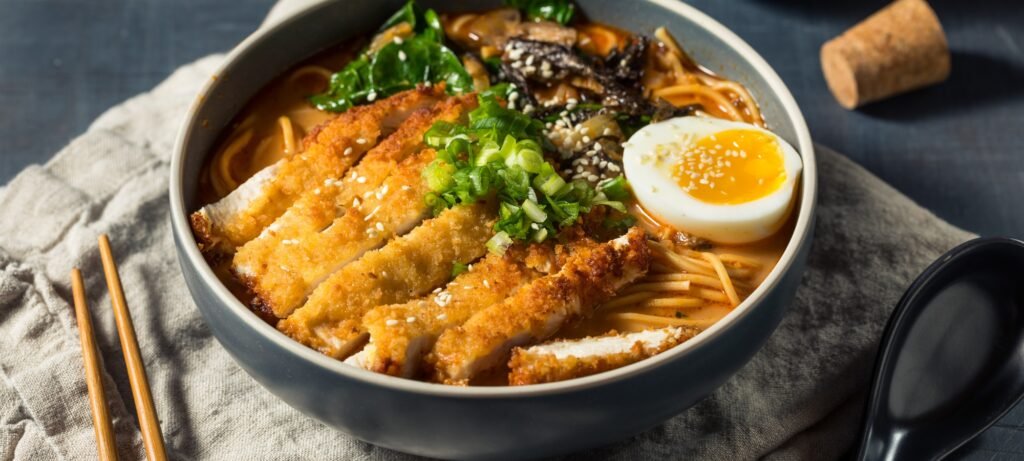Chicken ramen soup, known as tori ramen in Japanese cuisine, represents one of the most soul-satisfying and technically rewarding dishes in the culinary world. This beloved comfort food combines rich, collagen-laden chicken broth with perfectly cooked noodles and an array of carefully prepared toppings that create a harmonious bowl of pure satisfaction. While authentic ramen requires time and dedication, the results deliver restaurant-quality depth and complexity that transforms a simple meal into an extraordinary culinary experience that warms both body and spirit.
How To Make Chicken Ramen Soup

Ingredients
For the Chicken Broth:
- 3 pounds chicken bones (mix of backs, necks, and wings)
- 1 whole chicken (3-4 pounds)
- 2 onions, quartered
- 4-inch piece fresh ginger, sliced
- 1 head garlic, halved
- 2 leeks, cleaned and chopped
- 8 cups water
- 2 tablespoons sake
- Salt to taste
For the Tare (Seasoning Base):
- 1/4 cup soy sauce
- 2 tablespoons miso paste (white or red)
- 1 tablespoon sake
- 1 teaspoon sesame oil
- 1/2 teaspoon sugar
For the Chicken Topping:
- Reserved chicken meat from broth (shredded)
- 2 chicken thighs, boneless and skinless
- 2 tablespoons soy sauce
- 1 tablespoon mirin
- 1 teaspoon sesame oil
- 1 clove garlic, minced
For Assembly:
- 4 portions fresh ramen noodles
- 4 soft-boiled eggs, marinated
- 2 green onions, sliced
- 1 sheet nori, cut into strips
- 1/2 cup bamboo shoots (menma)
- Bean sprouts (optional)
- Corn kernels (optional)
Instructions
- Prepare the broth base: Place chicken bones in a large pot and cover with cold water. Bring to a boil and cook for 5 minutes to remove impurities. Drain and rinse bones thoroughly under cold water.
- Build the broth: Return cleaned bones to the pot with the whole chicken, onions, ginger, garlic, and leeks. Add 8 cups fresh water and bring to a gentle simmer. Skim foam regularly during the first hour of cooking.
- Simmer for richness: Continue simmering for 6-8 hours, maintaining gentle bubbles rather than a rolling boil. Add sake during the final hour. The broth should become rich, creamy, and deeply flavorful.
- Prepare the chicken topping: Remove the whole chicken from broth after 2 hours of simmering and set aside to cool. Continue simmering bones for remaining time. Once cool, shred chicken meat and set aside. For additional chicken, season the chicken thighs with soy sauce, mirin, sesame oil, and garlic. Pan-sear in a hot skillet for 6-7 minutes per side until cooked through. Let rest, then slice thinly.
- Strain and season: Remove solids and strain broth through fine-mesh strainer. The broth should be rich and gelatinous when cooled. Season with salt to taste.
- Prepare the tare: In a small bowl, whisk together soy sauce, miso paste, sake, sesame oil, and sugar until smooth. This seasoning base adds depth and complexity to each bowl.
- Cook the noodles: Bring a large pot of water to boil. Cook fresh ramen noodles according to package directions, typically 2-3 minutes. Drain immediately and divide among serving bowls.
- Assemble the bowls: Place 2-3 tablespoons tare in each bowl. Ladle hot broth over noodles, ensuring the tare dissolves completely. Top with generous portions of shredded and sliced chicken, soft-boiled egg halves, sliced green onions, nori strips, and bamboo shoots.
Mastering the Art of Chicken Broth
The foundation of exceptional chicken ramen lies in creating a rich, gelatinous broth that coats the mouth with luxurious texture and deep flavor. This process requires patience and understanding of how collagen breaks down into gelatin, creating the signature body that distinguishes authentic ramen from simple chicken soup.
The initial blanching step removes blood and impurities that would cloud the final broth, while the long, gentle simmer extracts maximum flavor and collagen from bones and connective tissue. The broth should simmer rather than boil vigorously, which would create a cloudy, greasy result instead of the desired clear, rich consistency.
Quality bones make an enormous difference in the final product. Seek out chicken backs, necks, and wing tips from butchers or Asian markets, as these cuts contain the highest concentration of collagen-rich connective tissue that creates ramen’s characteristic richness.
Noodle Selection and Preparation

Authentic ramen noodles possess specific characteristics that distinguish them from other Asian noodles: alkaline mineral content that creates their distinctive yellow color, chewy texture, and ability to maintain integrity in hot broth. Fresh ramen noodles from Asian markets provide superior results compared to dried alternatives.
The cooking time for fresh ramen noodles is typically very brief, usually 2-3 minutes in rapidly boiling water. Overcooking creates mushy texture that ruins the dish, while undercooking leaves an unpleasant raw flour taste. The noodles should maintain slight firmness similar to al dente pasta.
Portion control matters significantly with ramen noodles, as too many noodles overwhelm the broth while too few leave diners unsatisfied. Approximately 100-120 grams per serving provides the ideal balance between noodles and broth.
Essential Toppings and Their Roles
Each traditional ramen topping serves both aesthetic and functional purposes, contributing specific flavors, textures, and nutritional elements that create the complete ramen experience. Soft-boiled eggs provide richness and protein while their golden yolks enrich the broth when broken.
Marinated eggs, or ajitsuke tamago, require advance preparation but provide incredible flavor enhancement. Soak peeled soft-boiled eggs in a mixture of soy sauce, mirin, and sugar for at least 4 hours or overnight for deep, complex flavor that penetrates throughout the egg.
Green onions contribute freshness and mild bite that cuts through the broth’s richness, while nori sheets add oceanic umami and textural contrast. Bamboo shoots provide subtle earthiness and satisfying crunch that complements the soft noodles and tender protein.
Soft-Boiled Egg Perfection

Achieving perfectly soft-boiled eggs requires precise timing and temperature control. Bring water to a rolling boil, gently lower room-temperature eggs into the water, and cook for exactly 6-7 minutes depending on desired consistency. Immediately transfer to ice water to stop cooking.
The ideal ramen egg features firm whites and creamy, jammy yolks that remain slightly liquid in the center. This texture provides richness when mixed into the broth while maintaining structural integrity for attractive presentation.
For easier peeling, use eggs that are at least one week old, as fresh eggs tend to stick to their shells. The ice bath shock helps separate the membrane from the white, making peeling significantly easier.
Nutritional Benefits and Considerations
Well-crafted chicken ramen provides substantial nutritional value, combining high-quality protein from chicken and eggs, complex carbohydrates from noodles, and various vitamins and minerals from vegetables and seaweed. The long-simmered broth contains beneficial collagen and minerals extracted from bones.
However, ramen can be high in sodium due to the seasoned broth and tare. Balance this by increasing vegetable content, using lower-sodium alternatives where possible, and treating ramen as an occasional indulgence rather than daily meal.
The warming, satisfying nature of chicken ramen makes it particularly valuable during cold weather or when feeling unwell, providing both physical nourishment and psychological comfort that supports overall well-being and recovery.
Chicken ramen soup represents the perfect fusion of technique, patience, and creativity, offering home cooks the opportunity to master one of Japan’s most beloved culinary treasures while creating deeply satisfying meals that nourish both body and soul.
- Homemade Veggie Nuggets Recipe - November 30, 2025
- Kaiser Rolls Recipe - November 29, 2025
- Fried Green Beans Recipe - November 28, 2025

